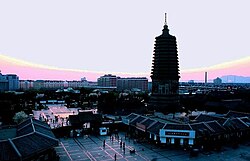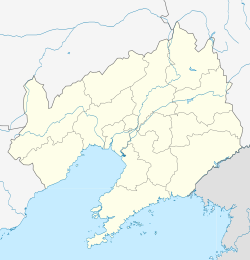Jinzhou
|
Jinzhou 锦州市 |
|
|---|---|
| Prefecture-level city | |
 |
|
 Location of Jinzhou City jurisdiction in Liaoning |
|
| Location of the city centre in Liaoning | |
| Coordinates: 41°07′N 121°08′E / 41.117°N 121.133°ECoordinates: 41°07′N 121°08′E / 41.117°N 121.133°E | |
| Country | People's Republic of China |
| Province | Liaoning |
| Districts and Counties |
List
|
| Government | |
| • CPC Party Secretary | Liu Zhiqiang (刘志强) |
| • Mayor | Wang Wenquan (王文权) |
| Area | |
| • Prefecture-level city | 10,111 km2 (3,904 sq mi) |
| • Urban | 535 km2 (207 sq mi) |
| • Metro | 535 km2 (207 sq mi) |
| Elevation | 24 m (78 ft) |
| Population (2010 census) | |
| • Prefecture-level city | 3,070,000 |
| • Density | 300/km2 (790/sq mi) |
| • Urban | 1,091,799 |
| • Urban density | 2,000/km2 (5,300/sq mi) |
| Time zone | China Standard (UTC+8) |
| Postcode | 121000 |
| Area code(s) | 416 |
| ISO 3166 code | cn-21-07 |
| Licence plates | 辽G |
| Administrative division code | 210700 |
| Website | www |
Jinzhou (/ˈdʒɪnˈdʒoʊ/,simplified Chinese: ; traditional Chinese: 錦州; pinyin: Jǐnzhōu) is a prefecture-level city of Liaoning province, People's Republic of China. It is a geographically strategic city located in the "Liaoxi Corridor" (辽西走廊), which connects land transportation between North China and Northeast China. Jinzhou is China's northernmost seaport and the coastal economic center of West Liaoning on the north-western shore of the Bohai Sea. The total area under the jurisdiction of Jinzhou is 10,111 square kilometres (3,904 sq mi), most of which is rural, encompassing a coastline of 97.7 km (60.7 mi).
It is one of the biggest cities in Liaoning with a population of 3,126,463 at the 2010 census, of whom 1,091,799 reside in the built-up area made of 3 urban districts.
Jinzhou is an ancient city with over a thousand years of history. Originally known as Tuhe (), it was part of Yan in the Warring States period. Under the Qin dynasty, the majority of what is now Jinzhou became part of Liaodong township. It was part of Changli township in Youzhou during the Han dynasty and Three Kingdoms periods, but fell under the jurisdiction of Yingzhou in the Beiwei, Dongwei, and Beiqi periods, before becoming part of Liucheng township and then Yan township during the Sui Dynasty and Tang dynasty. During the Tang, it was the seat of the Andong township.
...
Wikipedia

